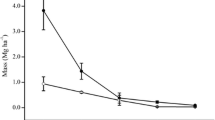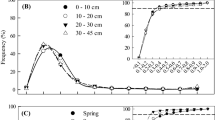Abstract
Background and aims
Knowledge of the fine root dynamics of different life forms in forest ecosystems is critical to understanding how the overall belowground carbon cycling is affected by climate change. However, our current knowledge regarding how endogenous or exogenous factors regulate the root dynamics of understory vegetation is limited. The aims of this study were to test the effects of soil moisture gradient and shading on the fine root production, phenology, and turnover rate of six shrub species from a subtropical forest.
Methods
We selected a suite of study sites representing different habitats with gradients of soil moisture and solar radiation (shading or no shading). We assessed the fine root production phenology, the total fine root production, and the turnover among six understory shrub species in a subtropical climate, and examined the responses of the fine root dynamics to gradients in the soil moisture and solar radiation. The shrubs included three evergreen species, Loropetalum chinense, Vaccinium bracteatum, and Adinandra millettii, and three deciduous species, Serissa serissoides, Rubus corchorifolius, and Lespedeza davidii. Results We observed that variations in the annual fine root production and turnover among species were significant in the deciduous group but not in the evergreen group. Notably, V. bracteatum and S. serissoides presented the greatest responses in terms of root phenology to gradients in the soil moisture and shading: high-moisture habitat led to a decrease and shade led to an increase in fine root production during spring. Species with smaller fine roots of the 1st+2nd-order diameter presented more sensitive responses in terms of fine root phenology to a soil moisture gradient. Species with a lower fine root carbon- to nitrogen ratio exhibited more sensitive responses in terms of fine root annual production to shading. Soil moisture and shading did not change the annual fine root production as much as the turnover rate.
Conclusions
The fine root dynamics of some understory shrubs varied significantly with soil moisture and solar radiation status and may be different from tree species. Our results emphasize the need to study the understory fine root dynamics in the achievement of a complete understanding of the overall belowground carbon cycling in a forest ecosystem, particularly ecosystems in which the understory fine root highly contributes to the belowground biomass.





Similar content being viewed by others
References
Aerts R, Berendse F, Klerk NM, Bakker C (1989) Root production and root turnover in two dominant species of wet heathlands. Oecologia 81:374–378
Anderson LJ, Comas LH, Lakso AN, Eissenstat DM (2003) Multiple risk factors in root survivorship: a 4-year study in Concord grape. New Phytol 158:489–501
Baddeley JA, Watson CA (2005) Influences of root diameter, tree age, soil depth and season on fine root survivorship in Prunus avium. Plant Soil 276:15–22
Burke MK, Raynal DJ (1994) Fine root growth phenology, production, and turnover in a northern hardwood forest ecosystem. Plant Soil 162:135–146
Edwards EJ, Benham DG, Marland LA, Fitter AH (2004) Root production is determined by radiation flux in a temperate grassland community. Glob Chang Biol 10:209–227
Espeleta JF, West JB, Donovan LA (2009) Tree species fine-root demography parallels habitat specialization across a sandhill soil resource gradient. Ecology 90:1773–1787
Finér L, Ohashi M, Noguchi K, Hirano Y (2011) Fine root production and turnover in forest ecosystems in relation to stand and environmental characteristics. For Ecol Manag 262:2008–2023
Fitter AH, Graves JD, Self GK, Brown TK, Bogie DS, Taylor K (1998) Root production, turnover and respiration under two grassland types along an altitudinal gradient: influence of temperature and solar radiation. Oecologia 114:20–30
Fitter AH, Self GK, Brown TK, Bogie DS, Graves JD, Benham D, et al. (1999) Root production and turnover in an upland grassland subjected to artificial soil warming respond to radiation flux and nutrients, not temperature. Oecologia 120:575–581
Gill RA, Jackson RB (2000) Global patterns of root turnover for terrestrial ecosystem. New Phytol 147:13–31
Gray AN, Spies TA, Easter MJ (2002) Microclimatic and soil moisture responses to gap formation in coastal Douglas-fir forests. Can J For Res 32:332–343
Hendrick RL, Pregitzer KS (1996) Temporal and depth-related patterns of fine root dynamics in northern hardwood forests. J Ecol 84:167–176
Hertel D, Strecker T, Müller-Haubold H, Leuschner C (2013) Fine root biomass and dynamics in beech forests across a precipitation gradient – is optimal resource partitioning theory applicable to water-limited mature trees? J Ecol 101:1183–1200
Huang G, Zhao X, Zhao H, Huang Y, Zou X (2010) Linking root morphology, longevity and function to root branch order: a case study in three shrubs. Plant Soil 336:197–208
Huang Z, Yu Z, Wang M (2014) Environmental controls and the influence of tree species on temporal variation in soil respiration in subtropical China. Plant Soil 382:75–87
Joslin JD, Wolfe MH, Hanson PJ (2000) Effects of altered water regimes on forest root systems. New Phytol 147:117–129
Joslin JD, Wolfe MH, Hanson PJ (2001) Factors controlling the timing of root elongation intensity in a mature upland oak stand. Plant Soil 228:201–212
Kitajima K, Anderson KE, Allen MF (2010) Effect of soil temperature and soil water content on fine root turnover rate in a California mixed conifer ecosystem. J Geophys Res 115:G04032
Lemmon PE (1956) A spherical densiometer for estimating forest overstory density. For Sci 2:314–320
Leppälammi-Kujansuu J, Salemaa M, Kleja DB, Linder S, Helmisaari H (2014) Fine root turnover and litter production of Norway spruce in a long-term temperature and nutrient manipulation experiment. Plant Soil 374:73–88
Liu G, Freschet GT, Pan X, Cornelissen JHC, Li Y, Dong M (2010) Coordinated variation in leaf and root traits across multiple spatial scales in Chinese semi-arid and arid ecosystems. New Phytol 188:543–553
Liu C, Xiang W, Lei P, Deng X, Tian D, Fang X, Peng C (2014) Standing fine root mass and production in four Chinese subtropical forests along a succession and species diversity gradient. Plant Soil 376:445–459
Liu B, Li H, Zhu B, Koide RT, Eissenstat DM, Guo D (2015) Complementarity in nutrient foraging strategies of absorptive fine roots and arbuscular mycorrhizal fungi across 14 coexisting subtropical tree species. New Phytol. doi:10.1111/nph.13434
McCormack ML, Adams TS, Smithwick EAH, Eissenstat DM (2012) Predicting fine root lifespan from plant functional traits in temperate trees. New Phytol 195:823–831
McCormack ML, Adams TS, Smithwick EAH, Eissenstat DM (2014) Variability in root production, phenology, and turnover rate among 12 temperate tree species. Ecology 8:2224–2235
Mooney HA, Chu C (1974) Seasonal carbon allocation in Heteromeles arbutifolia a California evergreen shrub. Oecologia 14:295–306
Norby RJ, Jackson RB (2000) Root dynamics and global change: seeking an ecosystem perspective. New Phytol 147:3–12
Oechel WC, Strain BR, Odening WR (1972) Tissue water potential, photosynthesis, C-labeled photosynthate utilization, and growth in the desert shrub Larrea divaricata. Cav Ecol Monogr 42(2):127–-141
Padilla FM, de Dios MJ, Armas C, Pugnaire FI (2015) Effects of changes in rainfall amount and pattern on root dynamics in an arid shrubland. J Arid Environ 114:49–53
Palacio S, Montserrat-Martí G (2007) Above and belowground phenology of four Mediterranean sub-shrubs. Preliminary results on root-shoot competition. J Arid Environ 68:522–533
Peek MS, Leffler AJ, Ivans CY, Ryel RJ, Caldwell MM (2005) Fine root distribution and persistence under field conditions of three co-occurring Great Basin species of different life form. New Phytol 165:171–180
Rytter R (2013) The effect of limited availability of N or water on C allocation to fine roots and annual fine root turnover in Alnus incana and Salix viminalis. Tree Physiol 33:924–939
Steinaker DF, Wilson SD (2008) Phenology of fine roots and leaves in forest and grassland. J Ecol 96:1222–1229
Tierney GL, Fahey TJ, Groffman PM, Hardy JP, Fitzhugh RD, Driscoll CT, Yavitt JB (2003) Environmental control of fine root dynamics in a northern hardwood forest. Glob Chang Biol 9:670–679
Trenberth KE (1983) What are the seasons? B Am Meteorol Soc 64:1276–1282
Valenzuela-Estrada LR, Vera-Caraballo V, Ruth LE, Eissenstat DM (2008) Root anatomy, morphology, and longevity among root orders in Vaccinium corymbosum (ericaceae). Am J Bot 95(12):1506–1514
Valverde-Barrantes OJ, Raich JW, Russell AE (2007) Fine-root mass, growth and nitrogen content for six tropical tree species. Plant Soil 290:357–370
Vogt KA, Vogt DJ, Palmiotto PA, Boon P, Ohara J, Asbjornsen H (1996) Review of root dynamics in forest ecosystems grouped by climate, climatic forest type and species. Plant Soil 187:159–219
Volder A, Gifford RM, Evans JR (2007) Effects of elevated atmospheric CO2, cutting frequency, and differential day/night atmospheric warming on root growth and turnover of Phalaris swards. Glob Chang Biol 13:1040–1052
Wells CE, Glenn DM, Eissenstat DM (2002) Changes in the risk of fine-root mortality with age: a case study in peach, Prunus Persica (rosaceae). Am J Bot 81(1):79–87
Wen X, Wang H, Wang J, Yu G, Shun X (2010) Ecosystem carbon exchanges of a subtropical evergreen coniferous plantation subjected to seasonal drought, 2003–2007. Biogeosciences 7:357–369
West JB, Espeleta JF, Donovan LA (2004) Fine root production and turnover across a complex edaphic gradient of a Pinus palustris-Aristida stricta savanna ecosystem. For Ecol Manag 189:397–406
Wilcox CS, Ferguson JW, Fernandez GCJ, Nowak RS (2004) Fine root growth dynamics of four Mojave desert shrubs as related to soil moisture and microsite. J Arid Environ 56:129–148
Xia M, Guo D, Pregitzer KS (2010) Ephemeral root modules in Fraxinus mandshurica. New Phytol 188:1065–1074
Xu W, Liu J, Liu X, Li K, Zhang D, Yan J (2013) Fine root production, turnover, and decomposition in a fast-growth Eucalyptus urophylla plantation in southern China. J Soils Sediments 13:1150–1160
Acknowledgments
We thank Dali Guo and Bitao Liu for their valuable comments regarding earlier versions of the manuscript. This work was funded by the National Key Basic Research Special Foundation Project (2012CB416903), the NSFC Projects of International Cooperation and Exchanges (31210103920), the National Natural Science Foundations of China (41101203), and the Gan-Po Distinguished Researcher Program.
Author information
Authors and Affiliations
Corresponding author
Ethics declarations
Compliance with Ethical Standards The authors have declared that no potential conflicts of interest exist, no specific permissions were required for these activities and the field study did not involve endangered or protected species.
Additional information
Responsible Editor: Alexia Stokes.
Rights and permissions
About this article
Cite this article
Fu, X., Wang, J., Wang, H. et al. Response of the fine root production, phenology, and turnover rate of six shrub species from a subtropical forest to a soil moisture gradient and shading. Plant Soil 399, 135–146 (2016). https://doi.org/10.1007/s11104-015-2686-z
Received:
Accepted:
Published:
Issue Date:
DOI: https://doi.org/10.1007/s11104-015-2686-z




